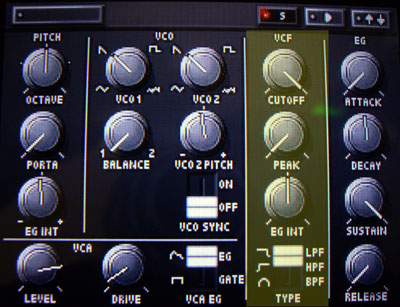A low-pass filter (LPF) lets the low frequencies go through and removes (attenuates) the high frequencies.
A high-pass filter lets the high frequencies go through and removes the low frequencies.
A band-pass filter lets the frequencies within the band go through and removes both the low and high frequencies.
As you probably know, a sound is a combination of sine waves of various frequencies and amplitudes. For a given sine wave, amplitude relates to how high and low the sine wave goes. When the sine wave frequencies are all whole-number multiples of the lowest frequency sine wave, the waves are called harmonics and the lowest frequency wave is known as the fundamental. The harmonics above the fundamental are commonly called overtones. Filters basically remove some of the harmonics of a sound.

Above is what you see when you go into SYNTH EDIT for synth1 or synth2. In this post, we focus on the VCF (Voltage Controlled Filter).
The CUTOFF is the threshold frequency for the various types of filters that are available (see the slider switch at the bottom): LPF (lowpass), HPF (highpass) and BPF (bandpass). In the case of the bandpass filter, the cutoff frequency is a misnomer as it should really be called the center frequency. Note that the cutoff frequency can be modulated with an LFO (Low Frequency Oscillator) or in Korg's jargon, a MG (Modulation Generator) for interesting effects.
The PEAK refers to a phenomenon called resonance. When resonance is applied to a filter, there occurs a signal gain (as opposed to a cut) near the cutoff frequency. The peak directly relates to the amount of resonance applied, in other words, the gain.
EG INT refers to filter modulation by the internal envelope generator (the controls to the right). An envelope generator shapes a note played on the keyboard into attack (voltage rises), decay (voltage drops), sustain (voltage stays put) and release (voltage drops) phases, commonly referred to as ADSR. The envelope generator output (voltage) modulates the cutoff frequency as a note is being played, from the time the key is pressed (attack) to the time it is depressed (release). As the voltage rises in the EG signal, the cutoff frequency rises to the maximum level set by the CUTOFF knob and as the voltage drops, the cutoff frequency drops. This is one way of modulating the filter.
On most analog synths, there are two envelope generators: one for the filter and one for the amplifier. On the Korg DS-10, there is only one for the amplifier but you have the capability to use that single envelope signal to modulate the cutoff frequency. So it's not too bad.
No comments:
Post a Comment